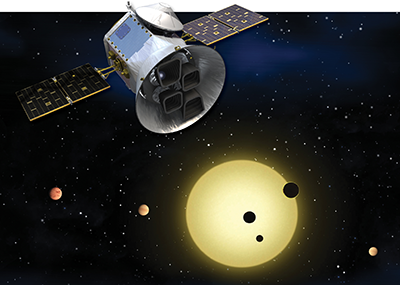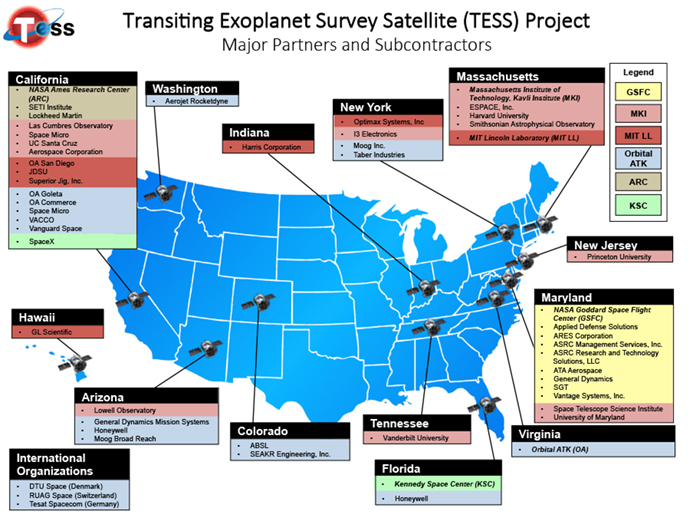This website is kept for archival purposes only and is no longer updated.
DISCOVERING NEW EARTHS AND SUPER-EARTHS IN THE SOLAR NEIGHBORHOOD
 The Transiting Exoplanet Survey Satellite (TESS) is an Explorer-class planet finder. In the first-ever spaceborne all-sky transit survey, TESS will identify planets ranging from Earth-sized to gas giants, orbiting a wide range of stellar types and orbital distances. The principal goal of the TESS mission is to detect small planets with bright host stars in the solar neighborhood, so that detailed characterizations of the planets and their atmospheres can be performed.
The Transiting Exoplanet Survey Satellite (TESS) is an Explorer-class planet finder. In the first-ever spaceborne all-sky transit survey, TESS will identify planets ranging from Earth-sized to gas giants, orbiting a wide range of stellar types and orbital distances. The principal goal of the TESS mission is to detect small planets with bright host stars in the solar neighborhood, so that detailed characterizations of the planets and their atmospheres can be performed.
TESS will monitor the brightnesses of more than 200,000 stars during a two year mission, searching for temporary drops in brightness caused by planetary transits. Transits occur when a planet's orbit carries it directly in front of its parent star as viewed from Earth. TESS is expected to catalog more than 1,500 transiting exoplanet candidates, including a sample of ∼500 Earth-sized and ‘Super Earth’ planets, with radii less than twice that of the Earth. TESS will detect small rock-and-ice planets orbiting a diverse range of stellar types and covering a wide span of orbital periods, including rocky worlds in the habitable zones of their host stars.
Partners:
The lead institution for TESS is the Massachusetts Institute of Technology (MIT), which hosts the Principal Investigator, Dr. George Ricker. The MIT Lincoln Laboratory is responsible for the cameras, including the lens assemblies, detector assemblies, lens hoods, and camera mount. NASA's Goddard Space Flight Center provides project management, systems engineering, and safety and mission assurance. Orbital ATK (OA) builds and operates the spacecraft. The mission is operated from the OA Mission Operations Center.
The TESS Science Center, which analyzes the science data and organizes the co-investigators, collaborators, and working groups (with members from many institutions) is a partnership among MIT's Physics Department and Kavli Institute for Astrophysics and Space Research, the Smithsonian Astrophysical Observatory, and the NASA Ames Research Center. The raw and processed data are archived at the Mikulski Archive for Space Telescopes, at the Space Telescope Science Institute.

ALL-SKY, TWO YEAR PHOTOMETRIC EXOPLANET DISCOVERY MISSION
TESS will tile the sky with 26 observation sectors:
TESS observes from unique High Earth Orbit (HEO):
TESS has been selected by NASA as an Astrophysics Explorer mission.
